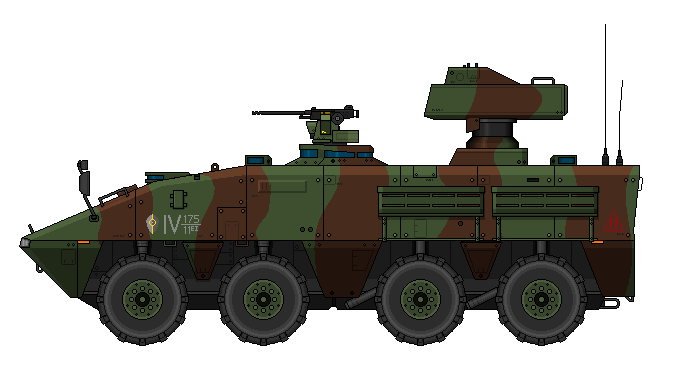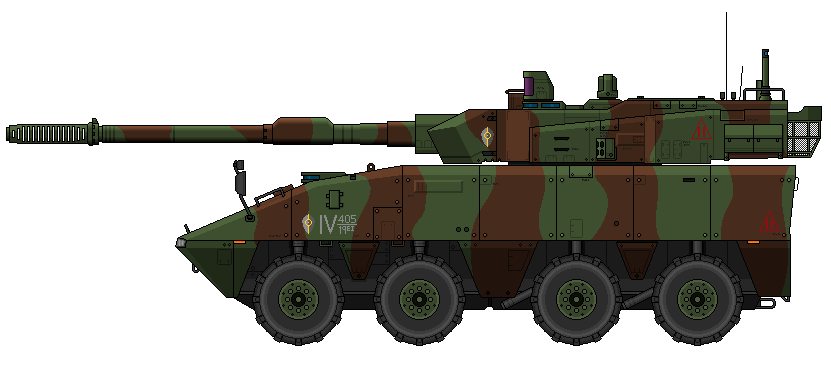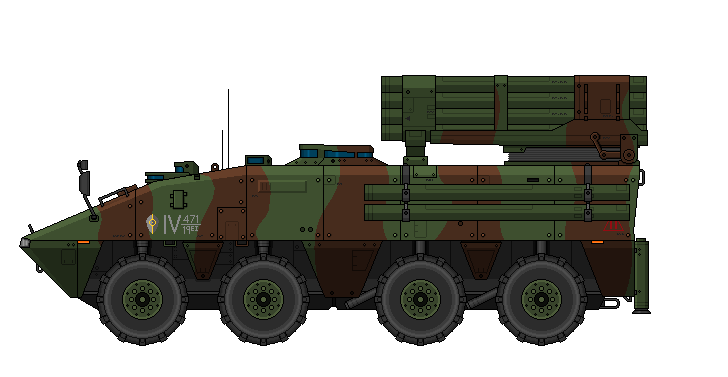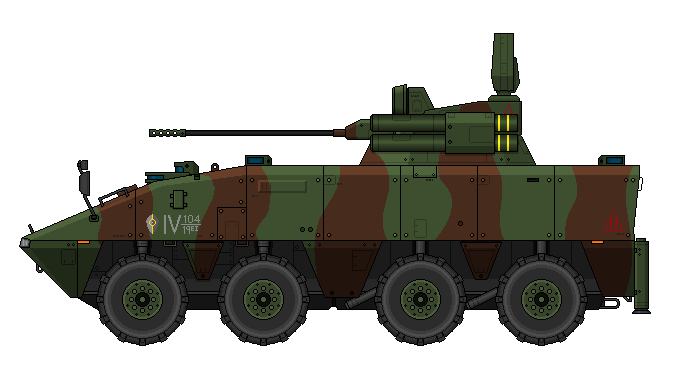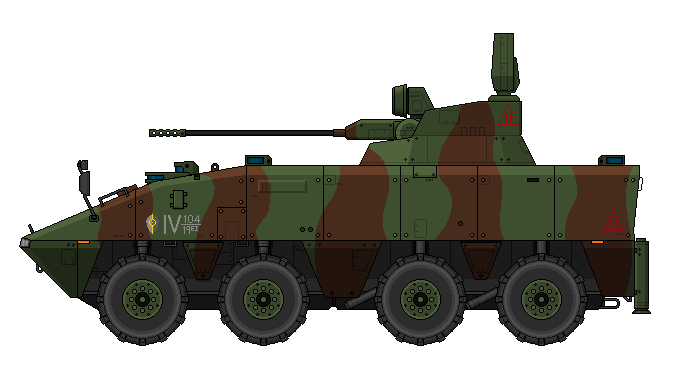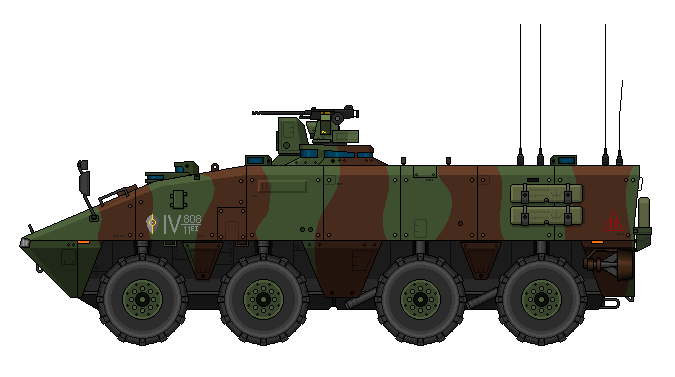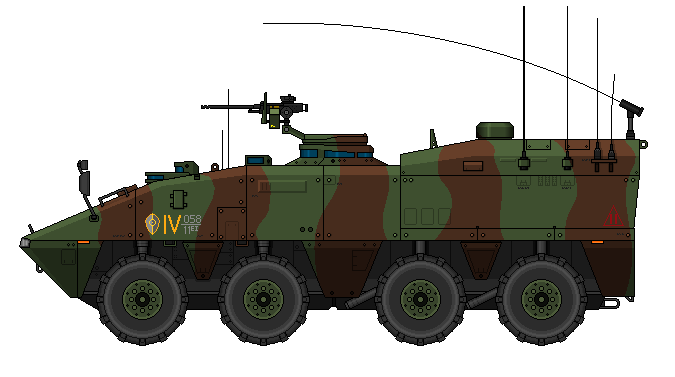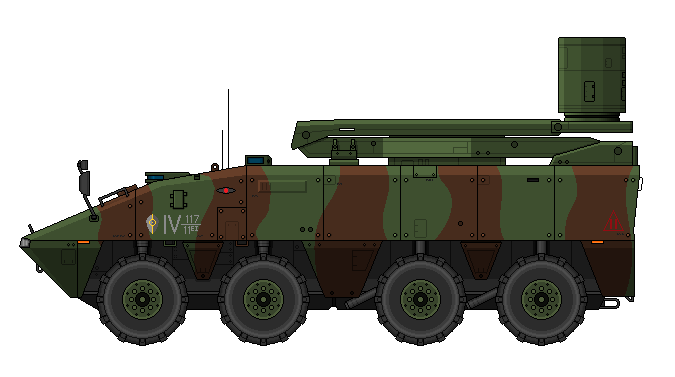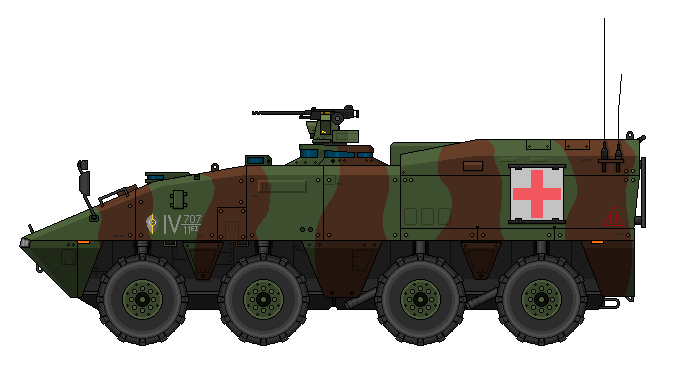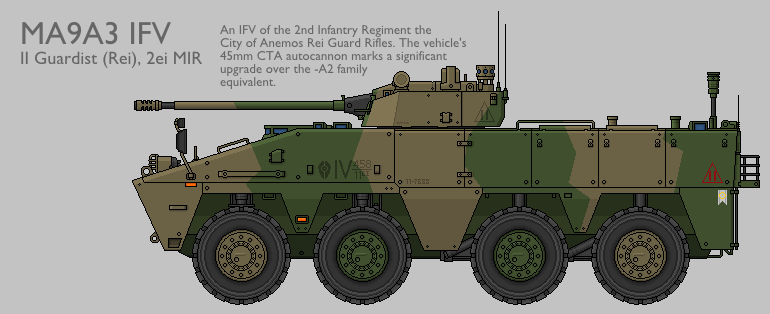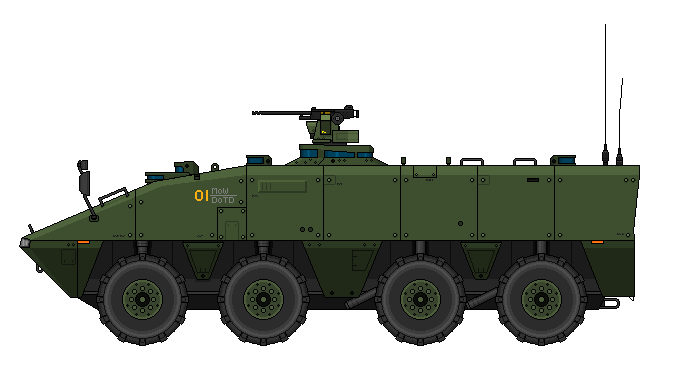
MA9A2 WMAV Prototype Vehicle 01, Directorate of Technological Development (Ministry of War)














"What's better than a soldier who does his job well? A soldier who does every job well."
-Second Marshal Alentyr Imranei, 1972

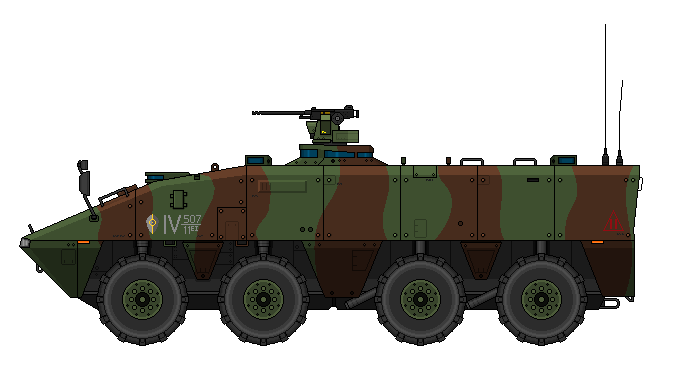
MA9A2 WMAV APC, 2nd Infantry Regiment the City of Anemos Rei Guard Rifles Regiment, on training exercises in Barony Myrstirei

Designation:
Numerical Designation: MA9A2 APC
Name: MA9A2 Armoured Personnel Carrier
Key Data:
Crew: 2 (Commander, Driver) + 10
Cost: 2.2 million NSD
Dimensions:
Length: 7.85m
Height: 2.4m
Width: 3.0m
Weight: 19t ( w/ RWS)
Performance:
Maximum Speed: 115km/h road speed
Acceleration: 0 to 32kph in 8.0 seconds
Operational Range: 780km
Armament:
Main Armament: 12.7mm MG/H8A3 on Remote Weapons System (powered, 2400 rounds), interchangeable with other armaments.
Additional: 12x mounted multipurpose grenade launchers, modular systems allow for further options.
Protection:
Passive: Base structural armour (metal-composite matrix outer layer, Type 7720 Titanium-Aluminium alloy, fibreglass/rubber/Spectra spall liner) with Orlontis modular armour addons
Active: Orenthel Active Protection System
Crew Protection: NBC protection (main + auxiliary), pentafluoroethane crew and passenger compartment fire extinguishing, Halon 1301 + foam fuel tank extinguishing and self-sealing suite.
Electronics:
SAIC Combat Networking
Power:
Propulsion: MA.450-1 650hp (484.70kW) 12L V8 triple sequential-parallel turbocharged diesel
Transmission: Automatic (6 forward, 2 reverse).
Suspension: Hydractive
Power/Weight: 34.21hp/tonne

The MA9A2 WMAV (Wheeled Modular Armoured Vehicle) family is a series of 8x8 wheeled vehicles developed under the auspices of the Anemonian Project Fiensietyr to create an indigenous series of armoured vehicles capable of filling a large number of roles effectively and efficiently, employing a highly modular armour and equipment layout to allow for the creation of multiple role specific variants with minimal modification. With eighteen variants of the vehicle in service with the Imperial Armed Forces of Anemos Major (APC, IFV, ATGM, VLATGM, MGS, SPGM, MLRS, SHORADS, RV, CBRNRV, CV, BCR, MEV, LMV, FOV, EV, ARV, MLV), of which thirteen are currently offered for export, the MA9A2 is a highly protected and portable high mobility vehicle, serving as both the mainstay of the Anemonian Mechanised Forces and in a support role for the Armoured, combining the sophistication of Anemonian technological prowess with the practicality of Anemonian experience to create a highly capable series of combat vehicles designed to achievement battlefield flexibility across a wide number of areas, and dominance within each of them.

With the retirement of the MA8A5 Tracked Armoured Personnel Carrier after some thirty long years of service, and its replacement by the VAB family of armoured vehicles following the 1994 military reforms that were to bring about far-reaching changes within the Anemonian military establishment, the last indigenous personnel carrier to be used by the Anemonian Crown Army for nearly twenty years passed from service ingloriously, obsolescent and disliked. A notoriously faulty vehicle, its retirement was a matter of virtual necessity for the Crown Army; with the introduction of the VAB the Crown Army was provided with an effective solution for its personnel carrying and multirole armoured needs that was to persist for nearly two decades.
However, as was the case with much of the materiel procured during this period, the VAB's fatal flaw lay in the fact that its development and production were both overseas affairs. With the self-sufficiency focal resurgence observed within the military-industrial complex in the early years of the 21st century, the decade following the 1994 military reforms was one which saw a subsequent shift towards the adoption of indigenously procured equipment. As funding rises continued to grow, movements towards the replacement of the 1994 vintage equipment by domestic alternatives began to grow in significance and influence, the result of which was the issuing of initially developmental, then productive contracts by the Imperial Office of War, and the Crown Army's roster of armoured vehicles was no exception. As early as 2001, significant political pressure was being placed on the Army's HT9 tank development program to ensure the creation of a domestically developed and produced vehicle, with vast subsidisation in play to ensure a domestically favourable result in the initial stage competition. With an RFI issued in 2003 by the Crown Army concerning the development of a lightweight wheeled armoured vehicle for personnel carrying purposes, the same trend seemed set to force the VAB into retirement a decade after its adoption. Though the aim of the program was simply to create a domestically developed and produced alternative to the VAB, and though it would eventually result in the relatively new vehicle's early retirement, the development of the MA9 program beyond its original aims would result in the extension of the program by some five years beyond its originally envisaged schedule and the creation of an entire family of vehicles far more innovative and flexible in its design than the original RFI called for.
The first vehicle of the MA9 family was a straightforward affair; a straight copy of the VAB in concept, and produced by Arsenal Fierei IECpl in a low profile program with the sole purpose of replacing foreign materiel with virtually identical domestic alternatives. MA9 in its initial form, formally known as IMA9 to reflect the vehicle's position as a prototype, was a stretched 8x development of the VAB, retaining the vehicle's base structure while incorporating a larger 450hp powerplant to compensate for its added weight. An unambitious vehicle which was to be developed within two years as a means of removing the VAB, IMA9 was forced through a rapid developmental process with the aim of pushing it into production by late 2006 for distribution to front-line forces, roughly matching the projected fielding schedule of what was then known as the HT9A6. Initial testing indicated a number of faults with the new powerplant, which in turn pushed the initial production of the vehicle behind schedule; as a result, the MA9's design was finalised by February 2006 and by then, the procurement environment had changed radically.
In January 2006, following field testing of the HT9A6 in Asakura, the decision was taken to redevelop the tank in its entirety in an alternate direction to remedy some significant issues observed in the performance efficiency of the tank's 140mm ETC main armament in combat. This decision was accompanied by a general review of the many programs precipitated by the funding rises of the new century, performed by more scrutinising eyes whose focus lay more in materiel efficiency than simple domestic economic concerns; many were quickly scrapped due to clear cost inefficiency issues. This swathe of procurement reviews and cancellations was significant enough to reach less prioritised programs such as the then MA9 WAPC, and where many were cancelled, the Crown Army was more reluctant to halt development of a new generation wheeled APC. A significant portion of the Army staff remained of the view that the adoption of the VAB in 1994, a vehicle of questionable age and utility in a world of tracked and 8x8 vehicles, had been a premature and deeply flawed decision, leading to a semi self-defeating state of affairs within their service which resulted in a branch of the Army upon which much more doctrinal importance had been placed in the aftermath of the 1994 reforms being equipped with substandard vehicles with which to perform their mission. It had become increasingly clear during the procurement review that the MA9 was a stopgap vehicle with very little in terms of practical superiority over the vehicle it was set to replace, but that the VAB required a replacement nonetheless; as a result of this, the decision was taken to redevelop the MA9 similarly to the HT9A6, and this marked the commencement of the MA9 developmental program in its currently recognisable form. From the creation of a domestically produced wheeled APC to provide cosmetic changes in the materiel composition of the Crown Army, the program shifted to the development and production of an entire family of highly ambitious and combat flexible wheeled armoured vehicles capable of going toe-to-toe with the most modern vehicles of its kind on the modern battlefield. Responsibility for the program was taken from Arsenal Fierei's hands and transferred to FOAM, the government-subsidised corporate alliance responsible for the development of the HT9 main battle tank, and the vehicle's evolution into its production form began in earnest.
Over the three year re-developmental period taken by FOAM to create the MA9A2, the vehicle's conceptualisation radically away from its original form. Though the 8x8 layout was maintained, the design of the vehicle shifted from the VAB-inspired construction of the IMA9 towards a vehicle that reflected the design of modern wheeled 8x8s like the Type 96 WAPC or VBCI, both of which had been procured in limited numbers by several exploratory committees within the Crown Army prior to the redefinition of the MA9 program in an effort to develop Anemonian technological and doctrinal expertise in the field of armoured personnel carrying 8x8s. This resulted in a greater weight than the VAB derivative vehicle that the IMA9 had been, which required a larger powerplant; in turn, FOAM turned their attention to the creation of a new, more powerful engine which departed from the MIDR utilised in the VAB in its design. The defining change in the MA9's design, however, was the adoption of a modular construction; not only employing modular armour layouts, the new MA9 employed a flexible rear construction to lower the costs of variant development and production, greatly increasing the potential range of roles which the new MA9 would be able to fill as a vehicle at a far lower cost. These major changes resulted in the creation of the MA9A1 prototype vehicle by 2008, tested by FOAM in battlefield conditions under the auspices of the Imperial Office of War to determine its effectiveness as an item of combat equipment in field service. Overall, the results of the testing were highly favourable; however, like so many armoured vehicles, the MA9A1's chronically underpowered and faultily designed powerplant were its bane. Redevelopment of the engine along different lines by FOAM with an added focus on power resulted in a satisfactory solution to the MA9A1's power-related troubles; the result was the creation of the MA9A2. Produced in a prototype form by FOAM in 2009 and presented to the Imperial Office of War, the MA9A2, already combat tested in a limited capacity, was ratified for service by the Crown Army Materiel Directorate with little delay and production commenced soon afterwards. By early 2010, the Crown Army began to receive the MA9A2 in larger quantities, and it quickly received its baptism of fire on the battlefields of Asakura in the service of frontline Mechanised formations.
In service, the MA9A2's conceptual flexibility proved that its transition into productive reality had been almost wholesale, with very little suggesting that the wide range of roles for which a variety of MA9A2 variants had been constructed were unsatisfactorily filled. As the MA9A2's field service continued, further feedback from troops resulted in the further development of the vehicle on the basis of field experience, such as the addition of a remote weapons system to various vehicles throughout the WMAV family, but the overall result of the MA9A2 program in its own right was clear. An 8x8 family of vehicles more than capable of providing the Anemonian Armed Forces with the combat dominance they required on the many battlefields to which they were deployed, and one of the most impressive vehicles to be born from the Anemonian automotive industry in a rare marriage of expertise between a number of Anemonian world leaders in a range of fields, the MA9A2 is a family of vehicles which covers a wide range of combat and non-combat roles in service and exerts characteristically Anemonian superiority and dominance across all of them. With hundreds of thousands of vehicles already procured by the Imperial Armed Forces, combat tested and trusted by those fortunate enough to utilise it on a day-to-day basis, the MA9A2 has developed from a relatively unambitious domestic production program into one of the finest vehicles of its kind in the modern day, unrivalled in its range of potential uses and its high performance in every case.

The main armament of the MA9A2 WMAV APC can vary, and the sole restriction is that it be able to fit on the variant of the Ortel Powered Remote Weapons System utilised by the vehicle. Capable of accepting anything up to a 40mm automatic grenade launcher, the station is usually equipped with the MG/H8A3 12.7mm machine gun in service. Capable of 360 degrees rotation, as well as +75, -25 elevation, the Ortel is a fully armoured RWS, utilising IRHA plating on sensitive areas like connections and optical equipment, equipped with optical, target acquisition and ballistic correction capabilities. Interfacing is achieved through a joystick for traversing and a 15-inch touch screen, which is linked in turn to a pair of cameras, one 3CCD daytime camera system and one forward-looking infra-red thermal imaging system. Both equipped with a laser rangefinding system, the gyrostabilised platform is able to offer a high degree of accuracy, even when on the move. Via the touch screen, the user is able to utilise both available optics to designate and ‘lock-on’ to targets, from where the laser rangefinder will feed distance information back to the ballistic computer which, utilising environmental data such as vehicle movement and round performance, will automatically adjust the firing arc to compensate for these. As such, the Ortel is capable of offering a high degree of accuracy, day and night, mobile or not, due to a high degree of environmental awareness and inbuilt ballistic correction capabilities that give it the ability to strike distant targets within seconds. As weapons fired from the Ortel tend to utilise electrical ignition, fire control (firing mode, safe) are all monitored and changed from within the vehicle itself. The primary weapon employed on the Ortel when in service on the WMAV APC is the 12.7mm MG/H8A3 Heavy Machine Gun. The MG/H8A3 is a short-recoil operated rotating bolt machine-gun utilising forced air cooling and forward porting to evacuate heat and propellant gases. With a barrel constructed of cold hammer forged steel, the external receiver of the weapon itself is, as a relatively new weapon, constructed of 30% glass reinforced polymer (making it relatively lightweight while remaining resistant to temperature buildups and sudden shocks), and the need for a replaceable barrel is largely removed through the installation of the highly efficient air cooling system. The ammunition is fed via a disintegrating link (a scaled up version of that utilised in the MG3/MG3R1 series’ 7.7mm ammunition), and the cyclic rate of fire of the weapon is mechanically alterable via the trigger block like the MG3 series, alternating between 450 and 750 rounds per minute as desired. The weapon itself is normally operated via a trigger located on the weapon’s spade trigger, but one of the differences between the infantry deployed and most vehicle deployed versions of the MG/H8A3 is the fact that they are, in fact, initial electrically ignited weapons (i.e. the initial trigger pull is replaced by electric ignition) to make them compatible with the HT9A7’s co-axial block system and greatly mechanically simplify the Remote Weapon Systems in service with the Anemonian Armed Forces. In general, two types of rounds are used with the MG/H8A3 as a component of the HT9A7 MBT; ball ammunition, for use against ‘soft’ targets, while HEIAP is employed for use against harder targets. The RWS is loaded at any one time with 200 rounds of ammunition fed by a box-stored link, with another 2,200 rounds stored within the vehicle in 200 round boxes for rapid reloading.
The use of a remote weapons system in the first place was a highly controversial option due to the additional weight burden posed by the incorporation of an RWS, especially a relatively heavy one like the Ortel; however, the high performance electronic aiming control and gun stabilisation of the Ortel in unison with the MG/H8A3's high performance against a range of unarmoured and lightly armoured targets has largely vindicated this decision, providing the MA9A2 with long range mobile firing capabilities usually associated with vehicles of a much higher weight range in a compact and protected package.

The passive protection suite of the MA9A2 is separated into two components, its base protective structure and its modular armour addons. The base structure of the MA9A2's armour is considered to be a component part of the MA9A2 vehicle itself, while its modular armour suite, Orlontis, was provided with a separate designation and is treated as an additional component. The utilisation of modular armour layouts with the MA9A2 in lieu of fixed vehicular armour is a key component of the WMAV's ability to thrive across so many different potential roles; with Orlontis, MA9A2 is as capable of acting as a quick response, air-portable base of fire as it is of acting as a heavily armoured direct support vehicle in frontline, armour supporting operations, and this flexibility is matched by the ease of replacement and operability exhibited by the Orlontis modular armour system, making it a very extant and very effective battlefield asset for operators of the MA9A2.
The basic protection suite of the MA9A2 is composed of its basic structural armour and spall liner, which make up the innermost portions of the MA9A2's armour suite. The basic structural armour is designed to combine maximum potential protection with controlled weight to allow the vehicle to exhibit its full air portability when stripped down to its base configuration, thus facilitating the vehicle's transportation and increasing reaction speed. As such, it is constructed of Type 7720. Type 7720 is a Titanium-Aluminium alloy exhibiting the usual properties of similar Titanium alloys in its role as an armouring metal while surpassing others significantly and convincingly; in more concrete terms, the primary characteristics exhibited by Type 7720 that make it so favourable a material are the combination of high stress resistance and toughness for its weight range, as well as corrosion and temperature resistance. The efficiency gains are made clear by the simple fact that Type 7720 is capable of exhibiting field performance of a similar nature to ceramic materials despite standing at roughly 38% the weight of an equivalent volume of rolled homogeneous armour; this combination of extraordinary weight savings coupled with ceramic-level properties makes it an ideal candidate for the structural armouring and composition of the MA9A2. Difficulties exist concerning the workability of titanium alloys without significant capital expenditure; however, as a collection of firms with industrial stakes and operations, FOAM had the added advantage of possessing said capital prior to commencing production, which greatly decreased the potential costs of widespread titanium alloy use. This Type 7720 base structural armouring is further complemented within the vehicle by a sophisticated spall protection liner. The liner itself is composed of 20% glass composition fibreglass, which is in turn backed by Spectra and rubber. This combination of materials expends any energy of incoming projectiles against the fibreglass liner, spreading energy across a wider area; any further cracking at the liner level is then absorbed by the polymer/rubber lining, thus preventing spall-effect projectiles from entering crew and cargo compartments in their entirety. This maximisation of interior safety is of particular importance for a family of vehicles like the MA9A2, which are more often than not responsible for the carrying of infantry; the base armour layout alone provides a degree of interior protection virtually unimaginable on vehicles like the VBL.
However, the cornerstone of the MA9A2's protective qualities lies in Orlontis, its uniquely modular family of armour additions that allow it to operate in a truly flexible fashion both on the battlefield and off, taking the protection of the vehicle from the small arms levels protected against by the base structure up to 35mm + areas and ensuring protection for the MA9A2 against the newer generations of weapons which it would be expected to face on the battlefield, including 30mm cannons in most basic armour configurations (which modern IFV level vehicles have begun to adopt in greater numbers as armour competence amongst extant armoured vehicles steadily increases). Orlontis, as an armour system, covers a wide variety of areas; as well as the frontal, side, top and rear armour suited of the MA9A2, Orlontis also provides optional IED protection and full slat armour options for protection against a wide variety of threats. The basic Orlontis armour layout, that which is expected to protect the vehicle from conventional threats, is generally composed of 'panels' of armour which are installed on various parts of the vehicle, the exact composition of which varies with the threats being faced by the vehicle and its desired weight range. The basic material employed in Orlontis armour plating is, again, Type 7720 Ti-Al alloy, which provides a marginally higher cost but greater efficiency alternative to traditional steel based armour materials like RHA. The Type 7720 employed in Orlontis is utilised as a composite with a similarly high efficiency ceramic, Titanium Diboride (TiB2). Titanium Diboride, explored and developed as an alternative to titanium carbide ceramics and composites during the development of the HT9A6 onwards, is a highly capable ceramic material which provides unrivalled levels of protection against most potential threats. At room remperatire, its hardness is almost three times that of the equivalent volume of fully hardened structural steel. Its melting point is also incredibly high, at 3225°C, and the result is that armour blocks incorporating normal Titanium Diboride tend to be both incredibly impact resistant and capable of withstanding the high heat generation of chemical energy warheads. Chemically, it is also a relatively field-friendly material, insofar as it is more stable than tungsten carbide when in contact with iron, and less prone to oxidation at anything short of extremely high temperatures. The combination of properties described above come together to create a material highly effective when defeating both high performance HE and KE rounds, and TiB2 is used in conjunction with Type 7720 in composite armour blocks to maximise the MA9A2's protection against a wide variety of ballistic threats. Unlike the ceramics utilised in the HT9A7, the TiB2 employed in Orlontis is not nano-treated; this is to reduce its material density, decreasing weight overall. This composite plating is then lined on the surface by an additional level of ballistic protection; a TiB2 based metal composite matrix with a fibreglass spall backing. This metal composite matrix, by being significantly harder than materials used in most ammunition-based applications, is capable of breaking up rounds, including penetrators, and, through the toughness of the metal composite matrix, results in the controlled distribution of kinetic energy absorbed from the round. As the controlled distribution results in the creation of a damage area only marginally larger than the size of the round from which energy has been transferred, with any spall effects absorbed by the fibreglass backing, the external protection is capable of sustaining multiple hits from anything up to the 12.7-14.5mm round range commonly utilised in modern heavy machine-guns. The resultant outer layer of armour protection is significantly lighter than the equivalent volume of RHA, and nonetheless capable of entirely stopping armour piercing small arms fire while significantly wearing down the effectiveness of high performance kinetic penetrators before they reach the armour blocks themselves.
The comprehensive protection provided by the basic Orlontis block, which can be modified in both composition and size, is further augmented by additional options provided by the modular armour suite in its entirety. NERA blocks, though heavy, can be added to the MA9A2. The NERA utilised within the MA9A2 is formed out of panels consisting of a 10mm thick layer of rubber lining sandwiched between two 6mm thick plates of steel (Domex Protect 500). When a projectile hits the NERA panel, resultant outward motion by the two Domex plates increases the effective thickness of the armour in that area, providing increased protection against projectiles. Furthermore, however, the lack of an explosive element means that the NERA utilised within the MA9A2 is both capable of taking multiple hits (to some extent) and causes no resultant collateral damage, as well as being far more resistant to the effects of a tandem charge warhead; both in terms of protection and resultant damage, it is a more desirable form of protection. Orlontis also comprises slat armour, which can be fitted around the vehicle to provide space protection against HEAT rounds by providing the vehicle with an impact and limited proximity fuzed HEAT ordnance premature detonation mechanism, and is composed of thin 'blades' of 5xxx series Aluminium-Manganese alloy fitted together in a structure of the same material to provide protection against incoming fuzed projectiles in a fashion that limits damage to the main vehicle itself. Finally, Orlontis also incorporates a body-on-hull V-hull additional to the MA9A2 which is capable of providing the vehicle with IED and mine resistance via a V-shaped energy redirecting Type 7720 Ti-Al alloy hull addition, protecting crew and components from underside damage.

To provide active protection to the MA9A2, engineers at FOAM endeavoured to create a lightened and simplified version of the Solothel Networked Vehicle Protection System for use by the WMAV. Labelled Orenthel, this active protection system incorporates a portion of Solothel's soft-kill systems, while refraining from using systems perceived to be overly heavy and nonetheless capable of receiving additional modifications.
The detection system utilised by Orenthel is two-tiered, and aims to achieve the highest possible detection speed with a minimal number of false detects by utilising a range of data from different sources to create an accurate picture of the vehicle's combat environment, and thus maximise the effectiveness of its threat detection and thus prevention and interception. The first tier of the vehicle’s sensor system is a set of laser and IR warning sensors installed around the vehicle. Within each sensor unit, both coarse and fine resolution detection systems are employed to provide a wide degree of coverage to the MA9A2. With overlapping sensor coverage, the system detects lasing and thermal signatures and is able to provide the crew not only with warnings, but informs them of the specific sector in which lasing has been detected, providing the crew with directional threat awareness that then allows for accurate reaction by both the crew and the automated threat response systems. The second tier of the detection system is a millimetre-wavelength radar based on flat panel additions around the vehicle and a single fixed unit to provide the MA9A2 with 360° degrees radar protection, allowing the MA9A2 to not only acquire incoming targets, but their speed, relative distance and profile to create an accurate picture of the projectile. The effectiveness of the system is, again, greatly increased by overlapping search sectors; together with the high performance processors utilised by Orenthel, this allows the overall target acquisition array to utilise its wide selection of sensors to achieve extremely high reaction speeds, greatly increasing the speed and thus effectiveness and success rate of its target interception. The two tiers of the system guarantee the accurate and effective threat detection of a number of different threats at a number of different ranges, and it is this effectiveness that gives Orenthel the ability to surpass and exceed most current active protection systems.
Smoke generation is usually achieved by a number of 80mm grenade units, generally varying from between twelve to twenty-four launchers with a total of anything between twenty-four to forty-eight canisters installed on the vehicle itself, and can be set to be launched via manual ignition or automatic ignition upon sensor reception. The exact parameters can be set in detail; as the different sensor equipment used by Orenthel, and to some extent profile comparison, allow it to identify reception information and categorise it, automatic smoke ignition can be set to occur within limited parameters, such as lasing.
The 80mm grenade launchers themselves are not restricted to a single type of ammunition. In some cases, they can be equipped with 80mm anti-personnel grenades; these utilise hexogen tolite as an explosive base for the directional shattering of a steel casing, resulting in a high-explosive/metal fragmentation based anti-infantry defence mechanism with the directional deployment of the device optimised by direct control by Orenthel itself, which is capable of utilising returns from its IR sensors if necessary to identify and eliminate hostile infantry forces (though this option can be turned off when operating in conjunction with allied infantry).
In terms of smoke, the MA9A2 is provided with two separate types of smoke for operation in close proximity to unarmoured elements, and operation in open areas against hostile forces. This differentiation is necessary due to the nature of the smoke composition used in each grenade. The ‘A’ model, designed with operation in close proximity to non-protected elements in mind, utilises the explosive dispersal of chlorosulfuric acid to spread out an aerosol smoke cloud and reduce the acid concentration of the hydrochloric and sulphuric acid produced as a result of the reaction. To compensate for the resultant reduced effectiveness of the smoke cloud, the smoke composition also contains fine metal coated carbon fibres to act as obscurants in the millimetre wave region, thus allowing Composition A to provide the MA9A2 with adequate protection in a variety of ranges. Composition B differs slightly from Composition A in that, while retaining the explosive dispersal mechanism and the carbon fibre content to act as a radar obscurant, the actual chemical composition of the smoke grenade has been changed to a white phosphorous-based composition. This is due to the pyrophoric qualities of WP; because it burns when put into contact with the air, it creates a short period of IR inhibition through a highly volatile exothermal reaction. Furthermore, the chemical content of Composition B grenades is increased in comparison to A, with the explosive dispersal lessened, due to the fact that it is designed solely for effectiveness and disregards general welfare due to its envisaged area of use; as such, Composition B grenades offer a much higher performance alternative to the MA9A2 when engaging hostile forces in the open field, a quick acting smoke grenade that, through the use of white phosphorous and metal coated carbon fibres and their explosive dispersal, create a quick blanket of thick smoke effective as an obscurant in the visible, infra-red and millimetre-wave spectrums to provide the MA9A2 with full spectrum defence. Of course, both Composition A and B are potentially harmful to those caught within the device’s area of effect upon ignition (without protective equipment in the case of A, and in either case with B), and as such, automatic deployment by Orenthel is an easily alterable option; Orenthel’s control mechanism, displaying flexibility as always, allows the crew to select the parameters within which the smoke canisters are to be deployed, ranging from full automation upon threat detection to complete manual control. As such, the 80mm grenade-based defensive suit utilised by the MA9A2 provides the vehicle's crew with a highly effective set of soft-kill defence mechanisms capable of block the target locks of weapons operators and in-flight munitions, but also allows them to minimise collateral damage via a selection of ammunition and the flexibility of the control system. In addition, unlike the basic Orenthel system employed by the YrC9, the MA9A2 is also equipped with a hard-kill component to its active protection measures; the system consists of a canister-based system employing the vertical launch of ‘grenade’ units. Similar to a grenadeT in appearance, this unit is similar to the anti-personnel 80mm grenades employed by the MA9A2's multipurpose launchers in principle; utilising a composition of hexogen tolite and RDX as its explosive base, these canisters directionally deploy titanium carbide ball bearings to intercept and destroy incoming projectiles. A soft launch mechanism propels the canister at high speed from its launcher, and impulse thrusters allow it to make rapid course corrections in mid-air before engaging and eliminating the target, either destroying it outright or destabilising it to the extent that it is incapable of effectively hitting the vehicle.

The MA9A2 APC, as an armoured personnel carrier, is primarily designed to ferry troops about the battlefield. As such, when compared to other vehicles within its family, the electronics suite of the APC is relatively rudimentary, limited to the base electronics of the MA9A2, required for its automotive operation, and the sighting systems incorporated on the RWS platform employed by the MA9A2. The two are combined to provide the APC with a nonetheless formidable degree of peripheral circumstantial awareness and those target identification and engagement capabilities required to make the MA9A2 an effective combat platform as far as necessary to fully complement its role as an APC in an efficient manner.
The primary sights employed by the vehicle's commander are the optronics mounted on board the Ortel RWS, composed of one 3CCD daytime camera system and one forward-looking infra-red thermal imaging system, both equipped with a laser rangefinding system for target acquisition purposes. Interfacing is achieved through a joystick for traversing and a 15-inch touch screen, as well as keyboard based control and additional LCD touch screens for command purposes and optics mode selection. Additionally, the commander is provided with a 360 degrees CCD vision block for rapid environmental situational awareness updates and maintenance; the visual feeds can be displayed and cycled through on the commander's panoramic LCD touch screen displays to provide a comprehensive picture of the vehicle's immediate surroundings.
The driver employs two main visual inputs. The first of these is his forward facing 3CCD vision block and FLIR units. Incorporated into the area directly in front of the entry hatch, the driver's forward facing optronic data inputs are presented, like the commander, on three 30cm LCD touch screens placed before the driver's station in a panoramic arrangement to facilitate data acquisition and awareness. The driver employs a standard driving wheel configuration for the purposes of steering the vehicle, for ease of familiarity when in use. The two stage forward facing visual data inputs provide the driver with effective day or night vision in a highly accessible package, facilitating the simple but arduous task of driving the vehicle. Additionally, the driver is provided with four CCD cameras placed at the vehicle's corner's to provide near-complete peripheral vision; this allows for the execution of manoeuvres including rearward movement and turns without physically moving from the driver's station, with the driver able instead to utilise rearward camera feeds to fully control the vehicle from the driver's station.
The MA9A2’s networking system, due to the high quantity of information sharing between the MA9A2 and various organisational structures at both a vertical and horizontal level, is designed to be both high performance on paper and usable in a variety of different manners to ensure that the high specifications of the MA9A2 are not only used independently, but to their full extent when coordinated with other vehicles and, vertically, in conjunction with other assets. The MA9A2’s combat networking suite, labelled SAIC, connects the individual tank to the Anemonian Crown Army’s CombatNet (supporting units up to the battalion level). CombatNet, due to the introduction of the ICS21 program, is a battalion networking system utilises by everything from Mechanised infantrymen to artillery batteries, and is universally employed to facilitate integration into control networks at a higher level (BattleNet, WarNet etc). Rather, instead of utilising completely different software for each combat asset networked into the Crown Army’s C4I structure, CombatNet utilises a combination of base software together with asset-specific modules (for tank units, mechanised infantry, artillery and other assets) to simplify networking logistics while catering to the specific needs of individual combat assets to create a system that is both efficient and effective. At its most basic level, CombatNet is a cartographic display. With rapid updating enabled at the platoon, company and battalion level, this cartographic display is able to show blue force and enemy troop locations and movements as detected by allied assets, operational plans fed down from various levels, as well as status reports and information from various levels to greatly increase the level and quality of group coordination, amalgamating the myriad of information entering the system via a highly capable Geographical Information System.
SAIC is also utilised to manage the MA9A2’s communications suite. The high capacity combat network radio employed by SAIC for limited range communications is a high capacity data radio operating as a frequency-hopping system in the UHF range (225-450 MHz), and supports high data transfer speeds to permit the utilisation of the HCDF connection for rapid and secure voice and data transfer and communications between vehicles for limited distance level coordination. At this level, the MA9A2 is also capable of employing IEEE 802.11 standard encrypted wireless local area networks for inter-vehicle connection. E-WLAN connectivity permits vehicles to achieve high speed, ad-hoc networking supporting secure data, video and voice transfers between individual WMAVs. A chipset incorporated into the computer utilises an encryption algorithm to secure access to Crown Army level WLAN networks, employing COMSEC/NETSEC encryption, meaning that enemy access or viewing of such networks is impossible, especially in the combat environments where the use of such systems is envisaged. For communications and networking at higher speed and longer range, SAIC is also equipped with digital broadband connectivity with satellite and stationary fibre-optic links; though such tactical internet connections allow for theatre-wide secure high speed connection, data transfers and features such as extended inter-formation communication and messaging, not to mention commercial internet interfacing if necessary, and though most Anemonian theatre-wide networking hubs of this kind employ automatic network formation and autonomous organisation, together with interconnection by utilising individual users not only as recipients but as intermediary nodes, to maximise speed (over six time the speed of HCDF connections when transmitting messages, for example), ease of use and efficiency by removing the need for a significant dedicated communications infrastructure, the reliability of such networks on the battlefield is nonetheless susceptible to enemy attack. As such, the MA9A2’s broadband internet connection is more of a ‘bonus’ feature permitted further effectiveness if usable; SAIC, and CombatNet, are designed to operate at maximum efficiency via the HCDF connection alone if necessary.
SAIC is also equipped with a highly effective computer malware detection and elimination system; this dynamic malware protection employs frequent database updates together with a connection to a central control system which both possesses a larger database and analyses the coding of unidentifiable threats to maximise its effectiveness against any threat, known or unknown, which manages to get past the MA9A2’s firewall.
The utilisation of SRAM, depleted boron coating of key computer chip arrays, partially redundant computer systems and error correcting memory arrays allows for system resistance, recovery and redundance against electromagnetic pulses and waves (as well as the metal hull of the vehicle itself), hardening the MA9A2 against such attacks and giving it the capacity to operate effectively in nuclear environments if so required.

One of the areas in which the MA9A2 departed earliest from its original base design, the VAB, was in its automotive components, starting with the engine but eventually spreading to include the whole vehicle. The MA9A2's increased weight over the VAB already necessitated a powerplant replacement; however, the potential for yet heavier variants, together with the many advances made in military vehicle automotive concepts and practices during the many years following the VAB's initial production meant that a first-class front-line vehicle would require radical shifts away from the antiquated or otherwise obsolescent design of the VAB, with a renewed focus on power in an efficient casing. The MA9A2's automotive components and layout were specifically chosen to balance a combination of technological superiority with practical efficacy; this, together with the initial faults observed in the vehicle's powerplant, meant that this was the area in which field testing results were most relied upon.
The powerplant employed in the MA9A2, the MA.450-1, is a relatively unorthodox V-engine designed to put as much power into a compact area as possible while utilising the turbocharger layout to minimise turbo lag, a phenomenon which would otherwise cause issues for combat vehicles like the WMAV. The engine employs a V8 layout, with eight cylinders in two banks of four arranged in a 'V' along the crankshaft assembly. The slightly larger displacement V8 engine layout, when compared to contemporary V6s as used in many similar vehicles, provides the MA9A2 with a relatively compact but nonetheless powerful housing for its 12L of cylinder capacity. The engine, a diesel engine, utilises air compression to generate power; to further increase the level of power generated by the engine, the MA.450-1 employs a triple turbocharger layout to provide turbocharged air compression at both low and high speeds with minimal turbo lag, providing the MA9A2 with augmented power generation at both low and high speeds and greatly reducing transitional lag. The original turbocharger layout in the MA.450 engine called for the utilisation of variable geometry turbochargers; this method employs vanes and axially sliding walls in the turbine inlet as a means of providing the turbocharger with an electronically controlled variable aspect ratio. This decreased turbo lag by altering the turbocharger's turbine inlet cross section so as to ensure that it remained at optimal levels across the MA9A2's speed ranges; this in turn permitted the use of a twin-turbo engine without the prospect of significant low speed turbo lag, and thus an engine capable of providing both power and practical performance for the MA9A2 as a battlefield vehicle. However, the primary disadvantage of the variable geometry turbocharger, its complexity, meant that the maintenance requirements of the MA.450 were very high despite its comparatively superior performance to its predecessors. With field use establishing that the use of the mechanically complex MA.450 was not a practically feasible option, the MA.450-1 was subsequently developed with the aim of simplifying the engine's construction while more or less retaining the advantages of its predecessor. The electronic air-flow control was maintained; however, instead of employing variable geometry within the turbochargers in order to modify aspect ratio, the MA.450-1 employs a sequential turbocharger layout to secure effective performance at both low and high speeds. The MA.450-1's turbocharger utilises one low-flow turbocharger and a twin-turbo parallel high flow turbocharger acting sequentially to provide the MA.450-1 with both low and high air flow turbochargers; acting in conjunction, the triple-turbo engine provides the MA9A2 with unrivalled power output by greatly increasing engine air compression over levels attainable by conventional turbocharged engines. On the other hand, MA.450-1 minimises turbo lag by ensuring that low air flow turbocharging can be performed by isolating the high air flow twin turbochargers via electronically controlled valves, thus restricting compression and turbine flow depending on the levels required for optimal operation by the engine. Unlike the VG turbocharged MA.450, MA.450-1 does not rely on a complex system of rotating vanes; rather, when the air flow capacity of the first turbocharger is exceeded by optimal level requirements, the valves to the second twin turbochargers are opened to release air flow and compression. The minimisation of turbo lag in this fashion increases the engine's responsiveness greatly, providing the MA9A2 with a relatively mechanically simple but nonetheless highly effective powerplant for operations across roles. The 12L V8 MA.450-1, utilising this triple sequential-parallel turbocharged diesel, is capable of generating 650hp (484.70kW) at steady state, for an impressive 34.21hp/tonne power-to-weight ratio that ably manages the heavier weight levels of some MA9A2 variants. The engine is placed in front of the crew compartment, at the front of the vehicle, in an isolated compartment. In order to monitor engine compression and valve opening, the MA.450-1 naturally required an electronic control system for powerplant management. This electronic control system was developed to manage the engine in its entirety, rather than turbocharger compression alone; with sensors monitoring the engine's internal conditions, the electronic control system is capable of presenting powerplant status information to the driver rapidly and effectively while performing its compression management tasks. MA.450-1 is complemented by an additional auxiliary power unit (APU) for emergency and low power purposes.
The MA9A2 utilises an eight gear automatic transmission for power transfer. With six forward and two reverse gears, the automatic transmission is placed alongside the engine block at the front of the vehicle in a powerpack layout to minimise the component's logistics burden. The torque converter employed in the transmission removes the need for a manually controlled mechanical clutch, automatically shifting gear ratios as necessary while mobile. The hydrodynamic torque converter operates independently from manual control by the driver, but mechanical restrictions can be placed on the transmission by the driver while in operation to control the range of gears through which the automatic transmission can cycle. These mechanical restrictions are controlled electronically; the electronic component actuation means that the driver is capable of controlling the transmission from the station's panoramic touch screen display; alternately, controls can be imposed via a set of physical buttons to the right of the driver's station. The torque converter and mechanical controls provide the MA9A2 with a combination of hydrodynamic and mechanical conventional braking; additionally, high performance carbon brakes are mounted for sustained and high power mechanical braking if necessary for quick stops or high speed braking. The WMAV's drivetrain can be shifted between four or all-wheel drive, as desired.
The suspension employed by the MA9A2, much like most modern Anemonian vehicles, is hydractive. The suspension operates around the same mechanical principles as a hydropneumatic suspension; the utilisation of an incompressible hydraulic fluid’s transfer within a ‘sphere’ to alter the pressure of nitrogen at the top of the sphere, in theory creating a suspension with an infinite number of potential positions. This theoretically infinite number of positions allows the MA9A2 to shift ride height and characteristics on the basis of circumstantial requirements and and operating environments, lending it a high degree of flexibility particularly important in the multirole doctrinal operating environments the MA9A2 is expected to serve within. Furthermore, in terms of ride characteristics, an uncompressed hydropneumatic suspension is softer than a steel spring, while a compressed one is capable of being harder than a fully contracted spring. This gives the hydraulic suspension the ability to display comfortable and stable ride characteristics in almost any situation, making it the ideal candidate for use within the MA9A2. The introduction of a hydractive system was one that simply increased the already significant inherent advantages of the hydraulic suspension. Sensors within various areas of the tank’s automotive parts feed data concerning speed and conditions to a computer control system. By gauging the nature of the ride conditions, the computer control system is able to modify the allocation and compression of spheres at millisecond speeds so as to alter the suspension to provide the optimal ride conditions under any circumstances, creating a constantly variable suspension of sorts capable of responding on the move to changes in terrain to maximise its effectiveness. Of course, fully automated suspensions are not necessarily the optimal solution considering the individual requirements of individual crews, and as such, a high degree of crew input into the system automation is also employed. It can be returned to ‘manual’ to turn it into a normal hydropneumatic suspension, of course (with a control interface that allows the driver to shift the position of the WMAV minutely and manually), but when in automatic, the ride characteristics can be set to a ‘constant’ preset (balances between handling against comfort), and the hydroactive suspension control systems will respond accordingly to keep the vehicle handling as close to the preset levels as possible across all terrain environments, greatly increasing the flexibility of the MA9A2’s suspension in the hands of the driver. Additionally, MA9A2 employs an electronically controlled and managed tire pressure control system for use from within the vehicle; pressure hoses within the tire, together with senses and pre-collated data, provide the driver with an accurate image of the pressure levels within the MA9A2's eight tires and the ability to modify the tire pressurisation and inflation at will to set levels from within the driver's station. As well as allowing the driver to shift ride height in conjunction with the hydractive suspension, the ability to alter the ride characteristics of the MA9A2 at will provides the driver with unprecedented levels of control over the vehicle and provides it with tracked-level cross country transit capabilities.

The MA9A2, designed first and foremost as a troop carrying vehicle, is designed to provide embarked personnel with high levels of both comfort and survivability without compromising the combat efficiency of the vehicle. The crew space is relatively confined, designed for compact but comfortable vehicle operation. However, in exchange for the relatively cramped crew spaces, the MA9A2 is able to provide embarked personnel in its APC configuration with a large cargo carrying volume, thus maximising the load bearing potential of the MA9A2 and its utility as an armoured personnel and personnel equipment carrying vehicle.
NBC protection is achieved via fully filtered dry air and climate control managed via an air outlet into the crew compartment. This NBC protection suite can be powered via the engine or the APU, allowing for functionality even when idle, and also serves to maximise crew comfort by allowing for a fully adjustable operating environment (ranging from humidity to temperature). In the event of system failure, the vehicle is also equipped with a smaller secondary NBC protection suite; this system supplies filtered air to individual crew stations, and is also equipped with personal ventilation masks to maximise the distribution of a limited supply of air.
Against fire, the crew and passengers are protected by one mechanism, while the engine is protected by another. Sensors within the crew and cargo (passenger) compartment are able to detect the outbreak of fires, and are connected directly to an automatically actuating pentafluoroethane fire extinguishing system, designed to minimise both crew and component damage while providing rapid fire control to ensure safety. A Halon-1301 based fire extinguishing system is employed within the MA9A2’s fuel tank and engine compartments; again, sensors are able to detect breaches in the fuel tank, and Halon-1301 is employed to neutralise explosive vapours. The tank itself is self-sealing, employing an open-cell polyether safety foam to ensure that fuel tank punctures are quickly dealt with to limit damage to the WMAV.
In terms of seating, as well as limited reclining and an adjustable head-rest, footpads, lower hull plating and a design that allows for minor seat displacement, the crew's seating is also fully mine protected (with shock isolation and redirection) to ensure that under-hull threats are protected against, both in terms of the vehicle but also from the shock to the crew compartment itself. Passenger seats are stowable to maximise troop carrying capacity; however, they are nonetheless shock isolated to provide under-hull explosive protection to the vehicle's passengers.The MA9A2 is fitted with minimum crew amenities for the purposes of semi-extended autonomous operation in adverse environments. As well as a large passenger/cargo compartment capable of stowing rations for consumption by troops, the MA9A2 is fitted with a water tap providing filtered water and a small refrigeration compartment to one side of the vehicle for liquid provision and storage. Additionally, an engine-powered electric hot-plate complements these tools to serve as rudimentary sources of food and water supply provision to crewmen while the vehicle is mobile; this allows for full crew and passenger supply provision under closed NBC protected conditions for a limited period of time if necessary. The electronics system of the MA9A2 is equipped to interface with a wide variety of commercial MP3 players (transmitted over the crew intercoms or over internal and even external loudspeakers, if so inclined) as well as connection to commercial internet via military broadband. In practice, however, the employment of such electronic interfaces during combat operations is greatly frowned upon by Anemonian officers (insofar as they result in concentration losses), resulting in the restriction of their use to peacetime operations.
Enquiries concerning exports and comments should be made via telegram or to the Anemonian State Arms Export Authority.





